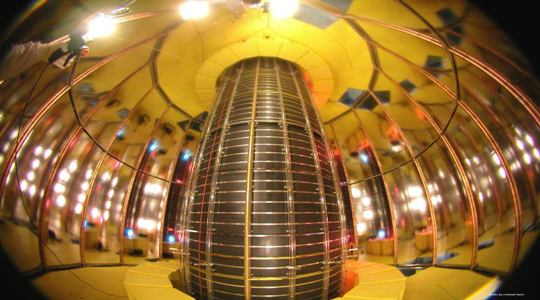 (News version only available in english) LHCb, one of the four major experiments at the LHC Large Hadron Collider, CERN’s supercollider in Geneva, reported the discovery of a class of exotic particles composed of five quarks, known as pentaquarks. The pentaquark that was observed is not simply a new particle but a new way in which quarks, which are the fundamental constituents of protons and neutrons, can combine with each other, and follows a pattern never observed before in over fifty years of experimental research. The result of the LHCb experiment is founded on extremely accurate and rigorous data analysis, based on very high-level statistics never achieved before, as well as on the extremely high accuracy of the detector. This result is not conclusive, as pentaquarks are a class of particles that can open the door to a much deeper understanding of matter. The next step will be to study how quarks are bounded within the pentaquarks. Further studies will therefore be needed, and the new data that LHCb will collect during LHC RUN2 will allow progress to be made in this field.
(News version only available in english) LHCb, one of the four major experiments at the LHC Large Hadron Collider, CERN’s supercollider in Geneva, reported the discovery of a class of exotic particles composed of five quarks, known as pentaquarks. The pentaquark that was observed is not simply a new particle but a new way in which quarks, which are the fundamental constituents of protons and neutrons, can combine with each other, and follows a pattern never observed before in over fifty years of experimental research. The result of the LHCb experiment is founded on extremely accurate and rigorous data analysis, based on very high-level statistics never achieved before, as well as on the extremely high accuracy of the detector. This result is not conclusive, as pentaquarks are a class of particles that can open the door to a much deeper understanding of matter. The next step will be to study how quarks are bounded within the pentaquarks. Further studies will therefore be needed, and the new data that LHCb will collect during LHC RUN2 will allow progress to be made in this field.
You might also be interested in

XENON100 IS CLOSING IN ON DARK MATTER
20 August 2015
Read more XENON100 IS CLOSING IN ON DARK MATTER

SAME MASS FOR NUCLEI OF MATTER AND ANTIMATTER
17 August 2015
Read more SAME MASS FOR NUCLEI OF MATTER AND ANTIMATTER

INFN AT THE CHINA SCIENCE FESTIVAL IN BEIJING

ULTRA FAST DETECTORS FOR PHOTOGRAPHING PARTICLES IN 4D

SULCIS: FROM THE MINE A RESOURCE FOR DARK MATTER AND APPLIED RESEARCH

FIFTH TAU NEUTRINO DETECTED BY OPERA
16 June 2015
Read more FIFTH TAU NEUTRINO DETECTED BY OPERA